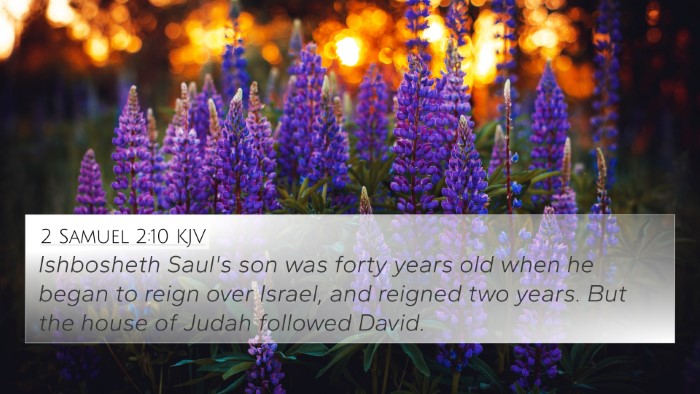Understanding 2 Samuel 3:14
Bible Verse: 2 Samuel 3:14 - "And David sent messengers to Ishbosheth, Saul's son, saying, Deliver me my wife Michal, which I espoused to me for an hundred foreskins of the Philistines."
Context and Background
This verse emerges during a tumultuous period in Israel's history post-Saul's reign, illustrating the political and personal dynamics at play following the fragmentation of Saul's kingdom. Michal, the daughter of Saul, originally married to David, serves as a pivotal character in a narrative filled with strife and ambition.
Historical Insights
- David's Claim: David's demand for Michal signifies both a personal desire and a political maneuver, reaffirming his status as Saul's chosen successor.
- Ishbosheth's Role: Ishbosheth's reluctance to return Michal underscores his weak grip on power and highlights the division within Israel.
- Significance of Marriage: In ancient Israel, marriage was often a means of establishing alliances; thus, David's request carries substantial political weight.
Commentary Insights
Matthew Henry
Matthew Henry emphasizes the intricate interplay between personal relationships and political leadership. He notes that David’s appeal for Michal reflects his rightful claim as her husband and symbolizes his desire to unite the kingdom under his rule. By reclaiming Michal, David seeks to assert his legitimacy as king.
Albert Barnes
Albert Barnes elucidates the significance of the foreskins David provided to secure Michal's hand in marriage. He points out that this act displays both bravery and cunning. Barnes further reflects on the emotional implications of Michal’s return to David, suggesting it indicates a broader restoration of David's familial ties and alliances.
Adam Clarke
Adam Clarke examines the socio-political context of the verse, highlighting how David's actions are rooted in a larger narrative of reclaiming authority. Clarke also suggests that Michal's position amidst the struggle between David and Ishbosheth emphasizes her role in the power dynamics of the time.
Theological Applications
This verse invites readers to consider broader themes within Scripture, such as the complexities of rightful leadership, the significance of covenant relationships, and the interplay of personal and public duty. It offers an exploration of God's providence in establishing David’s kingship despite turbulent circumstances.
Bible Verse Cross-References
- 1 Samuel 18:27: The initial account of David earning Michal as his wife.
- 2 Samuel 6:23: Michal's later relationship with David and her disdain for his actions.
- 1 Samuel 25:44: Saul's handing over of Michal to another man, illustrating her contested status.
- 1 Chronicles 15:29: Another reference to Michal's return and her interactions with David.
- Psalm 45:10-11: A reflection on a king's bride, drawing parallel themes of loyalty and love.
- Genesis 29:21-26: The theme of betrothal and marital exchanges in ancient Israel.
- Ruth 1:16-17: Covenant loyalty in familial relationships reflecting David and Michal's situation.
Connections Between Bible Verses
The relationship between David and Michal invites deeper exploration of the concepts of love, duty, and identity within the Old Testament. By examining the throughout the Biblical narrative, one can draw connections between David’s political maneuvers and the underlying theme of divine guidance steering the events of the king's rule.
Comparative Bible Verse Analysis
Through cross-referencing scriptures related to David’s reclaiming of Michal, one can identify thematic connections that resonate throughout the Bible. This enhances one’s understanding of the relational dynamics encapsulated in Biblical texts and contributes to a richer historical and theological insight.
Tools for Bible Cross-Referencing
For those engaged in study, employing a Bible concordance provides an invaluable resource for identifying and tracing these connections between verses. Using a cross-reference guide facilitates a deeper understanding of parallel narratives, allowing one to explore how individual stories reflect broader themes across scripture.
Conclusion
In summary, 2 Samuel 3:14 reveals layers of meaning intertwined with historical, relational, and theological significance. This verse reflects the complex interplay of leadership, longing, and loyalty, and serves as a springboard into a larger conversation about God’s providential hand throughout Biblical history.





